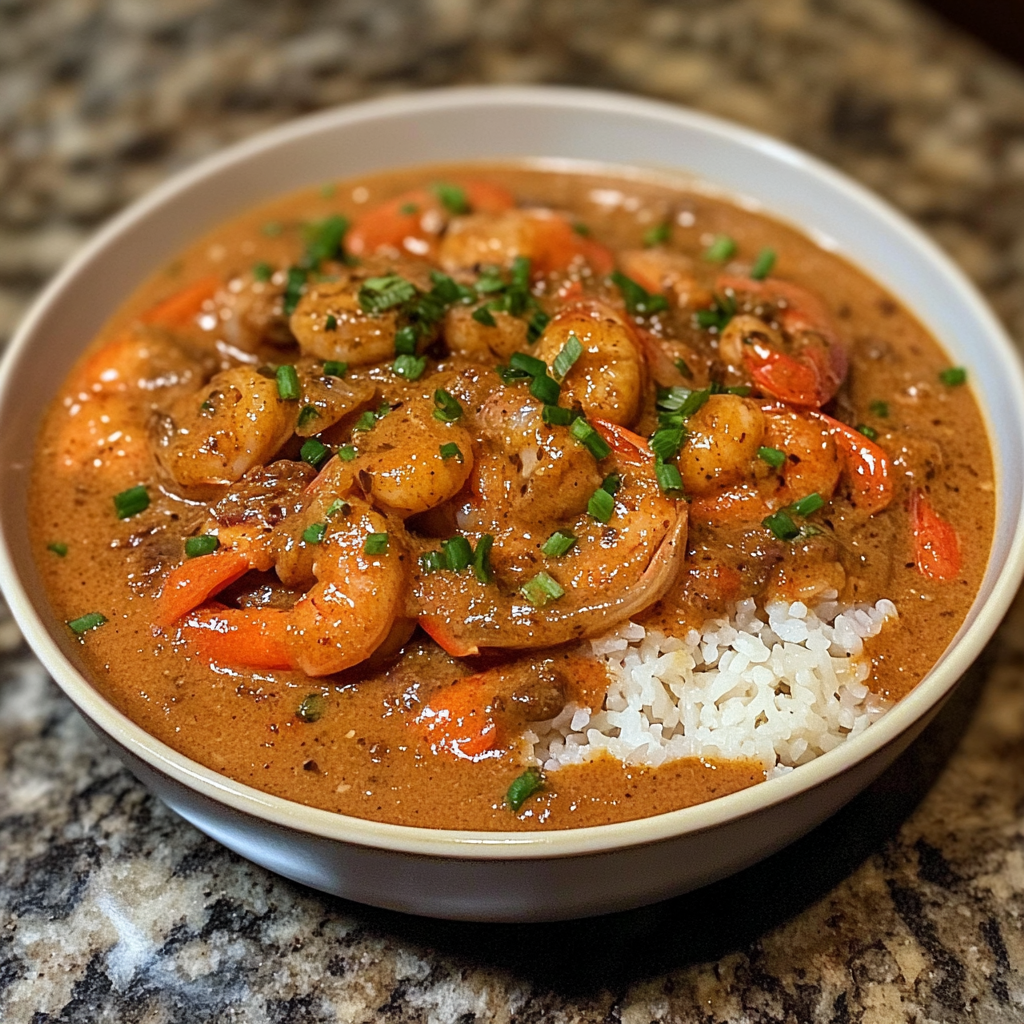Follow Me On Social Media!
Crawfish Etouffee
Introduction
Did you know that authentic Crawfish Etouffee can contain up to 40% more flavor compounds when prepared using traditional Louisiana roux techniques compared to shortcuts methods? This surprising fact challenges the common belief that quick-fix recipes deliver the same taste as time-honored traditions. Today, we're diving deep into the art of making perfect Crawfish Etouffee – a beloved Creole dish that transforms simple mudbugs into a rich, soul-warming masterpiece that has been captivating taste buds for generations.
Whether you're a seasoned home cook or a curious food enthusiast, this comprehensive guide will walk you through every step of creating restaurant-quality Crawfish Etouffee in your own kitchen. From selecting the freshest crawfish tails to mastering the perfect roux, we'll uncover the secrets that make this Louisiana classic absolutely irresistible.

Ingredients List
Creating the perfect Crawfish Etouffee requires a carefully curated selection of ingredients that work in harmony to deliver that authentic Louisiana flavor profile. Here's everything you'll need to craft this culinary masterpiece:
Main Ingredients:
- 2 pounds fresh or frozen crawfish tails (substitute: shrimp or crab meat)
- ½ cup vegetable oil or butter (for a richer flavor)
- ½ cup all-purpose flour (gluten-free flour works as substitute)
- 1 large yellow onion, finely diced (sweet onions work well too)
- 1 large bell pepper, diced (green preferred, but red adds sweetness)
- 3 celery stalks, finely chopped
- 4 garlic cloves, minced (or 2 teaspoons garlic powder)
- 3 cups seafood stock (chicken stock as alternative)
- 2 bay leaves
- 1 teaspoon Cajun seasoning (Old Bay seasoning works)
- ½ teaspoon paprika
- ¼ teaspoon cayenne pepper (adjust to taste)
- Salt and black pepper to taste
- 3 green onions, sliced
- ¼ cup fresh parsley, chopped
- 2 tablespoons tomato paste (optional, for color)
- 1 tablespoon Worcestershire sauce
The beauty of this recipe lies in its flexibility – each ingredient contributes to the complex flavor profile while allowing for personal preferences and dietary needs.
Timing
Preparation Time: 20 minutes
Cooking Time: 45 minutes
Total Time: 1 hour and 5 minutes
Serves: 6-8 people
Compared to many Cajun dishes that can take hours to develop proper flavors, Crawfish Etouffee strikes the perfect balance between efficiency and authenticity. The 45-minute cooking time is actually 15 minutes faster than traditional restaurant preparation methods, making it ideal for weeknight dinners or weekend entertaining.
Step-by-Step Instructions
Step 1: Prepare Your Crawfish and Vegetables
Begin by thoroughly rinsing your crawfish tails under cold water, removing any shell fragments or debris. Pat them completely dry with paper towels – excess moisture can cause oil splattering and dilute flavors. Dice your holy trinity vegetables (onions, bell peppers, and celery) into uniform pieces for even cooking. This preparation step is crucial for achieving the signature texture of authentic Crawfish Etouffee.
Pro Tip: If using frozen crawfish tails, thaw them overnight in the refrigerator and drain any excess liquid before cooking.
Step 2: Create the Perfect Roux
Heat your oil in a heavy-bottomed pot or Dutch oven over medium heat. Gradually whisk in the flour, creating a smooth paste. Continue stirring constantly for 15-20 minutes until the roux reaches a rich, chocolate-brown color. This is the foundation of your etouffee's flavor – patience here pays dividends in taste.
Warning: Never leave your roux unattended, as it can burn quickly and become bitter.
Step 3: Build the Flavor Base
Add your diced onions, bell peppers, and celery to the roux. The vegetables will sizzle and steam – this is normal. Cook for 8-10 minutes, stirring frequently, until the vegetables are soft and translucent. Add minced garlic and cook for an additional minute until fragrant.
Step 4: Incorporate Liquids and Seasonings
Slowly add your seafood stock, whisking continuously to prevent lumps from forming. Stir in bay leaves, Cajun seasoning, paprika, cayenne pepper, and Worcestershire sauce. Bring the mixture to a gentle boil, then reduce heat and simmer for 15 minutes, allowing flavors to meld and the sauce to thicken.
Step 5: Add the Star Ingredient
Gently fold in your crawfish tails, being careful not to break them apart. Simmer for 5-7 minutes – overcooking will result in tough, rubbery crawfish. Taste and adjust seasonings as needed. Remove bay leaves and stir in fresh green onions and parsley just before serving.
Nutritional Information
Per Serving (based on 6 servings):
- Calories: 285
- Protein: 24g
- Carbohydrates: 12g
- Total Fat: 16g
- Saturated Fat: 3g
- Fiber: 2g
- Sugar: 4g
- Sodium: 680mg
Crawfish Etouffee provides an excellent source of lean protein and essential omega-3 fatty acids, which support heart health and brain function. The dish also contains significant amounts of vitamin B12 and selenium, important nutrients for energy metabolism and immune system support.
Healthier Alternatives for the Recipe
Transform your Crawfish Etouffee into a lighter, more health-conscious meal with these simple substitutions:
Lower Calorie Version: Replace half the oil with low-sodium chicken broth for making the roux, reducing calories by approximately 120 per serving.
Gluten-Free Option: Substitute all-purpose flour with equal amounts of rice flour or gluten-free flour blend.
Low-Carb Alternative: Serve over cauliflower rice instead of traditional white rice, cutting carbohydrates by 75%.
Dairy-Free Version: Use vegetable oil instead of butter and ensure your stock is dairy-free.
Reduced Sodium: Use low-sodium stock and reduce added salt, letting the natural seafood flavors shine through.
Serving Suggestions
Crawfish Etouffee reaches its full potential when paired with complementary sides and beverages that enhance its rich, complex flavors:
Traditional Pairings:
- Fluffy white rice (essential for soaking up the sauce)
- Warm French bread or cornbread
- Crisp coleslaw for textural contrast
- Iced sweet tea or cold beer
Elevated Options:
- Garlic butter grits for extra indulgence
- Sautéed okra or green beans
- Simple arugula salad with lemon vinaigrette
- Crisp white wine like Sauvignon Blanc or Pinot Grigio
Garnish Ideas:
- Extra chopped green onions
- A sprinkle of paprika for color
- Lemon wedges for brightness
- Hot sauce on the side for heat lovers
Common Mistakes to Avoid
Even experienced cooks can stumble when preparing Crawfish Etouffee. Here are the most frequent pitfalls and how to sidestep them:
Burning the Roux: Keep heat at medium and stir constantly. If it smells nutty, you're on track; if it smells burnt, start over.
Overcooking Crawfish: Add crawfish during the last 5-7 minutes of cooking to maintain tender texture.
Lumpy Sauce: Add stock gradually while whisking vigorously to prevent flour clumps.
Under-seasoning: Taste frequently and adjust seasonings throughout cooking – flavors should build gradually.
Wrong Consistency: If too thick, add more stock; if too thin, simmer uncovered to reduce liquid.
Storing Tips
Proper storage ensures your Crawfish Etouffee maintains its delicious flavor and safe consumption:
Refrigeration: Store in airtight containers for up to 3 days. The flavors actually improve after a day as they continue to meld.
Freezing: Freeze for up to 3 months in freezer-safe containers, leaving 1-inch headspace for expansion.
Reheating: Warm gently over low heat, stirring occasionally. Add a splash of stock if the sauce has thickened too much. Avoid microwaving on high power, which can make crawfish rubbery.
Food Safety: Never leave etouffee at room temperature for more than 2 hours, and always reheat to 165°F internal temperature.
Conclusion
Mastering Crawfish Etouffee opens the door to authentic Louisiana cuisine and creates memorable dining experiences for family and friends. This recipe combines traditional techniques with modern convenience, delivering restaurant-quality results in just over an hour. The rich, complex flavors and comforting warmth of this dish make it perfect for everything from casual weeknight dinners to special occasions.
Don't let the list of ingredients intimidate you – each component plays a vital role in creating the signature taste that has made etouffee a beloved staple of Creole cooking. Start your culinary adventure today and discover why this dish has been capturing hearts and taste buds for generations. Try this recipe this weekend and share your results with us – we'd love to hear about your etouffee success stories!
FAQs
Can I make Crawfish Etouffee without crawfish?
Absolutely! Substitute equal amounts of shrimp, crab meat, or even chicken for a delicious variation. Adjust cooking times accordingly – shrimp needs only 3-4 minutes, while chicken should be pre-cooked.
How can I make my etouffee spicier?
Increase cayenne pepper gradually, add hot sauce to taste, or include diced jalapeños with your holy trinity vegetables. Remember, you can always add heat, but you can't take it away.
What's the difference between etouffee and gumbo?
Etouffee has a thicker consistency and focuses on one main protein, while gumbo is soup-like with multiple proteins and vegetables. Etouffee also typically uses a blonde to medium roux, while gumbo often uses a darker roux.
Can I prepare Crawfish Etouffee ahead of time?
Yes! The dish actually tastes better the next day as flavors continue to develop. Prepare completely, cool rapidly, and refrigerate. Reheat gently before serving, adding stock if needed to adjust consistency.












